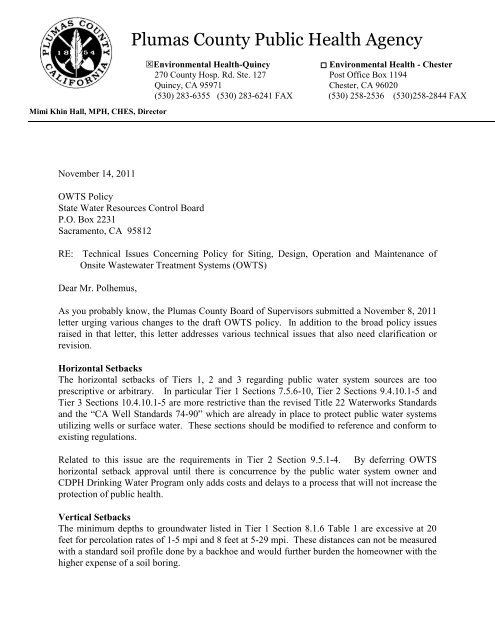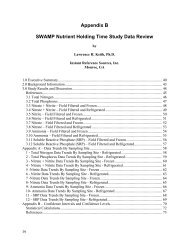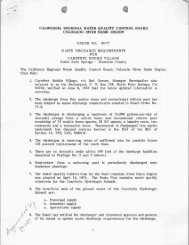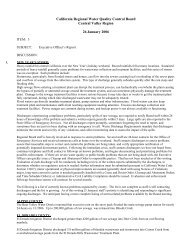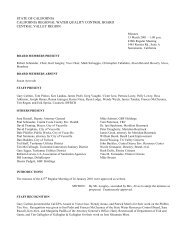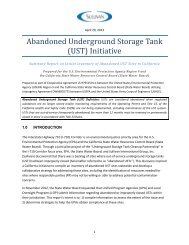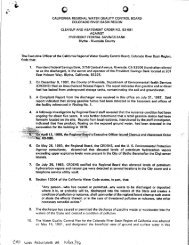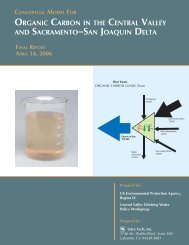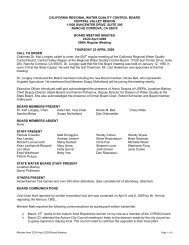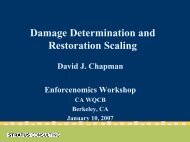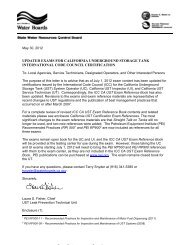Gerald Sipe - State Water Resources Control Board
Gerald Sipe - State Water Resources Control Board
Gerald Sipe - State Water Resources Control Board
Create successful ePaper yourself
Turn your PDF publications into a flip-book with our unique Google optimized e-Paper software.
Mimi Khin Hall, MPH, CHES, Director<br />
Plumas County Public Health Agency<br />
Environmental Health-Quincy<br />
Environmental Health - Chester<br />
270 County Hosp. Rd. Ste. 127 Post Office Box 1194<br />
Quincy, CA 95971 Chester, CA 96020<br />
(530) 283-6355 (530) 283-6241 FAX (530) 258-2536 (530)258-2844 FAX<br />
November 14, 2011<br />
OWTS Policy<br />
<strong>State</strong> <strong>Water</strong> <strong>Resources</strong> <strong>Control</strong> <strong>Board</strong><br />
P.O. Box 2231<br />
Sacramento, CA 95812<br />
RE: Technical Issues Concerning Policy for Siting, Design, Operation and Maintenance of<br />
Onsite Wastewater Treatment Systems (OWTS)<br />
Dear Mr. Polhemus,<br />
As you probably know, the Plumas County <strong>Board</strong> of Supervisors submitted a November 8, 2011<br />
letter urging various changes to the draft OWTS policy. In addition to the broad policy issues<br />
raised in that letter, this letter addresses various technical issues that also need clarification or<br />
revision.<br />
Horizontal Setbacks<br />
The horizontal setbacks of Tiers 1, 2 and 3 regarding public water system sources are too<br />
prescriptive or arbitrary. In particular Tier 1 Sections 7.5.6-10, Tier 2 Sections 9.4.10.1-5 and<br />
Tier 3 Sections 10.4.10.1-5 are more restrictive than the revised Title 22 <strong>Water</strong>works Standards<br />
and the “CA Well Standards 74-90” which are already in place to protect public water systems<br />
utilizing wells or surface water. These sections should be modified to reference and conform to<br />
existing regulations.<br />
Related to this issue are the requirements in Tier 2 Section 9.5.1-4. By deferring OWTS<br />
horizontal setback approval until there is concurrence by the public water system owner and<br />
CDPH Drinking <strong>Water</strong> Program only adds costs and delays to a process that will not increase the<br />
protection of public health.<br />
Vertical Setbacks<br />
The minimum depths to groundwater listed in Tier 1 Section 8.1.6 Table 1 are excessive at 20<br />
feet for percolation rates of 1-5 mpi and 8 feet at 5-29 mpi. These distances can not be measured<br />
with a standard soil profile done by a backhoe and would further burden the homeowner with the<br />
higher expense of a soil boring.
Density Limits<br />
The density requirement of Tier 1 Section 7.8 places an arbitrary restriction on new subdivisions<br />
and limits the use of OWTS to a minimum parcel size of 2.5 acres. Any minimum parcel size<br />
should be determined case-by-case, be project specific and based on site evaluation not an<br />
arbitrary regulatory number.<br />
Recreational Vehicle Dump Stations<br />
The prohibition of OWTS dedicated to receiving wastes from recreational vehicle (RV) holding<br />
tanks in Tier 2 Section 9.4.8 will negatively impact Plumas County. The existing RV dump<br />
stations in Plumas County are few in number and located in areas where other disposal options<br />
are not available. This restriction could eliminate dump stations and increase the probability of<br />
illegal dumping, adversely affecting both public health and the environment. This need not be a<br />
statewide prohibition; it should be negotiable in a Tier 2 program approved by the Regional<br />
<strong>Board</strong>.<br />
Tier 3 Requirements for Existing OWTS<br />
Tier 3 Sections 10.2-10.2.4 for existing systems should be rewritten to put the burden of proof<br />
for degradation on the Regional <strong>Board</strong>s. Even if Regional <strong>Board</strong> fails to adopt a TMDL and a<br />
contribution from OWTS is never established, the owner of an existing OWTS must comply with<br />
advanced treatment requirements within 7 years. Then, once the TMDL is completed and it does<br />
not allocate any load to OWTS, and the advanced treatment may no longer be necessary. Those<br />
installing advanced treatment in the interim will have spent a lot of money unnecessarily and<br />
without water quality benefit. Any requirements for OWTS upgrades of existing systems before<br />
a TMDL has been established should be eliminated.<br />
Optional inspection reports for existing systems are detailed in Tier 3 Section 10.3-10.3.2.<br />
Section 10.3.2 requires an OWTS owner to submit any inspection reports within 30 days of<br />
completion. An owner should not be required to submit a report, which he is paying for, to the<br />
<strong>Board</strong> unless he so chooses. This requirement is unenforceable and should be deleted. However,<br />
a reasonable time frame for action by the Regional <strong>Board</strong> should be added for those reports that<br />
are submitted as well as suspension of OWTS upgrade requirements during this period of <strong>Board</strong><br />
review.<br />
Tier 3 Requirements for New OWTS<br />
Tier 3 Section 10.6 requirements are for new OWTS within 600 feet of a 303(d) water body<br />
without a TMDL. The requirement for advanced treatment for nitrates and pathogens at this<br />
distance appears to be excessive and arbitrary rather than based on such parameters as OWTS<br />
density, soil type and percolation test results. Also, without an adopted TMDL there is no<br />
evidence that the OWTS are contributing to the problem. Costly advanced treatment systems,<br />
that may be unnecessary, should not be required. This requirement for new systems should be<br />
eliminated until a TMDL is adopted.
Clarifying Language<br />
Several sections in the policy use wording that triggers regulatory action yet are undefined,<br />
unclear in its meaning, or are contradictory. The following sections need clarification, revision<br />
or omission:<br />
Section 3.3—requires the “location” be provided for OWTS complaints and permits in<br />
the annual report. It does not seem necessary to track and report local OWTS activities to<br />
this level of detail.<br />
Tier 0 Section 6.1.2—refers to “high-strength wastewater from commercial food service<br />
buildings that does not exceed 900 mg/L BOD and has a properly sized and functioning<br />
grease interceptor (a.k.a. grease trap).” This restriction should be removed. If an<br />
existing system is operating properly, then it should be allowed to continue operation<br />
until it meets the conditions of Tier 4.<br />
Tier 0 Section 6.1.4—Clarification is needed that OWTS inundated by a flood event<br />
would not be automatically taken out of Tier 0 if the OWTS functions properly after the<br />
waters recede.<br />
Tier 1 Section 8.1.4—states that leach fields installed above native soil may be approved<br />
under Tier 2 but this is contradicted in Tier 2 Section 9.4.3 which states that any effluent<br />
disposal on or above the ground surface is not allowed. This section must be modified to<br />
permit above-ground (mound) systems in Tier 2.<br />
Tier 2 Section 9.1.2—uses the term “high quality waters”. The term is not defined or<br />
referenced to other existing regulations and should be removed.<br />
Tier 2 Section 9.1.3—refers to “dispersal system installation that is closer to the ground<br />
surface than is standard”. The intent of this section is not clear.<br />
Tier 2 Section 9.1.9—uses the term “watershed”. This term needs to be defined and<br />
clarified as to the intent of what the term encompasses.<br />
Tier 2 Section 9.4.10.4 and 9.5—uses the term “within the catchment of the drainage”.<br />
This term needs to be defined and clarified as to the intent of what the term encompasses.<br />
Tier 3 Prologue and Tier 3 Section 10.0—contains conflicting statements regarding<br />
existing OWTS near an impaired water body. The prologue states that existing systems<br />
must meet the Tier 3 requirements and Section 10.0 says “local agencies are not required<br />
to notice or enforce the requirements of Tier 3 for existing OWTS.” These conflicting<br />
statements need clarification.<br />
Tier 3 Section 10.4.3—prohibits any above ground effluent disposal. This section should<br />
be modified to permit above-ground mound systems in Tier 3.<br />
Thank you for your continuing work to make this policy workable for local implementing<br />
agencies. I look forward to working with you during the next revision cycle.<br />
Sincerely,<br />
<strong>Gerald</strong> <strong>Sipe</strong><br />
Plumas County Environmental Health


